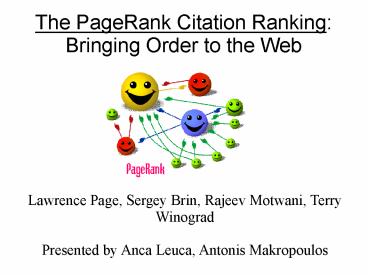The PageRank Citation Ranking: Bringing Order to the Web - PowerPoint PPT Presentation
Title:
The PageRank Citation Ranking: Bringing Order to the Web
Description:
The PageRank Citation Ranking: Bringing Order to the Web Lawrence Page, Sergey Brin, Rajeev Motwani, Terry Winograd Presented by Anca Leuca, Antonis Makropoulos – PowerPoint PPT presentation
Number of Views:234
Avg rating:3.0/5.0
Title: The PageRank Citation Ranking: Bringing Order to the Web
1
The PageRank Citation Ranking Bringing Order to
the Web
Lawrence Page, Sergey Brin, Rajeev Motwani, Terry
Winograd Presented by Anca Leuca, Antonis
Makropoulos
2
Introduction
- Web is huge
- The web pages are extremely diverse in terms of
content, quality and structure - Problem
- How can the most relevant pages of the user's
query be ranked at the top? - Answer
- Take advantage of the link structure of the Web
to produce ranking of every web page known as
PageRank
3
Link Structure of the Web
- Every page has some number of forward links
(outedges) and backlinks (inedges) - e1 and e2 are Backlinks of C
- We can never know all the backlinks of a page,
but we know all of its forward links (once we
download it) - The more backlinks, the more important the page
4
Simplified PageRank
- Innovation backlinks from high-rated pages are
very important! - A page with N outlinks redistributes its rank to
the N successor nodes - A page has high rank if the sum of the ranks of
its backlinks is high
5
Simplified PageRank (equations)
6
Simplified PageRank (equations)
7
Problem 1 Rank Sink
- Problem
- A, B and C pages form a loop that accumulates
rank (rank sink) - Solution
- Random Surfer Model
- jump to a random page based on some distribution
E (rank source)
8
Problem 2 Dangling Links
- Dangling links are links that point to any page
with no outgoing links or pages not downloaded yet
- Problem how to distribute their weight
- Solution they are removed from the system until
all the PageRanks are calculated. Afterwards,
they are added in without affecting things
significantly
9
PageRank (equations)
- E distribution over pages
- Democratic PageRank
- uniform over all pages with
d damping factor (usually equal to 0.85) Pages
with many related links end up with high rating
Personalized PageRank default or user's home page
Pages related to the homepage end up with high
rating
10
Computing PageRank
- S any vector over the web pages
- Calculate the Ri1 vector using Ri
- Find the norm of the difference of 2 vectors
- Loop until convergence
11
PageRank Example
A 1 2 3 4 1 0 0 0 0 2
1/3 0 0 0 3 1/3 1/2 0 1 4 1/3 1/2
1 0 Rank 1 URL 4 has PageRank value
0.4571875 Rank 2 URL 3 has PageRank value
0.4571875 Rank 3 URL 2 has PageRank value
0.048125000000000015 Rank 4 URL 1 has PageRank
value 0.037500000000000006
1
3
2
4
12
Quick overview
- Have talked about
- Web as a graph
- Why need page ranking
- PageRank Algorithm
- What's next?
- Actual implementation
- Testing on search engines
- Applications
- Web traffic estimation
- Pagerank proxy
13
Implementation
- Web crawler and indexer 24 million pages, 75
million hyperlinks - Input each link as unique ID in database
- Method
- Sort by parent ID
- Remove dangling links
- Assign initial ranks
- Start iterating PageRank
- After convergence add back dangling links
- Recompute rankings.
- Output a rank for each link in the database
14
Implementation - 2
- Memory constraints
- 300 MB for ranks of 75 million URLs
- Need both current ranks and previous ranks
- Current ranks in memory
- Previous ranks and matrix A on disk
- Linear access to database, since it is sorted
- Time span 5 hours for 75 million URLs
- Could converge faster if efficient initialization
15
Convergence
- Fast
- Scales well
- Because web is expander-like graph
16
Convergence Properties
- Expander graph graph where any (not too large)
subset of nodes is linked to a larger neighboring
subset - The web is an expander-like graph!
- PageRank ltgt Random walk ltgt Markov Chain.
- For expander graphs p' A/d p
- Markov Chain with uniform distrib stationary
distribution converges exponentially quickly to
uniform distribution - Nielsen2005
- Rapidly mixing random walk quick convergence to
a limiting distribution on the set of nodes in
the graph - The PageRank of a node the limiting
probability that the random walk will be at that
node after a sufficiently large time
17
Testing on search engines Title Search
18
Testing on search engines - Google
- Good quality pages
- No broken links
- Relevant results
- Source Brin98
19
Testing on Search engines
20
Applications
- Web traffic and PageRank
- Sometimes, what people like is not what they link
on their web pages! gt low ranks for usage data - Could use usage data as start vector for PageRank
- PageRank proxy
- Annotates each link with its PageRank to help
users decide which is more relevant
21
Conclusions
- PageRank describes the behavior of an average web
user - Fast computation even in 1998
- Although famous, the paper is unclear about the
actual computation of PageRank. - No statistical results for the tests
- References
- Brin98 - The Anatomy of a Large-Scale
Hypertextual Web Search Engine, Sergey Brin,
Lawrence Page, 1998 - Nielsen2005 - Introduction to expander
graphs, M. A. Nielsen, 2005




























![[1] L. Etzkorn et al.: ``Automated reusability quality analysis of OO legacy software,'' Information and Software Technology, Vol. 43, Issue 5, pp. 295-308 (2001). PowerPoint PPT Presentation](https://s3.amazonaws.com/images.powershow.com/6950957.th0.jpg?_=20150727128)


![[1] L. Etzkorn et al.: ``Automated reusability quality analysis of OO legacy software,'' Information and Software Technology, Vol. 43, Issue 5, pp. 295-308 (2001). PowerPoint PPT Presentation](https://s3.amazonaws.com/images.powershow.com/8537632.th0.jpg?_=201702231111)